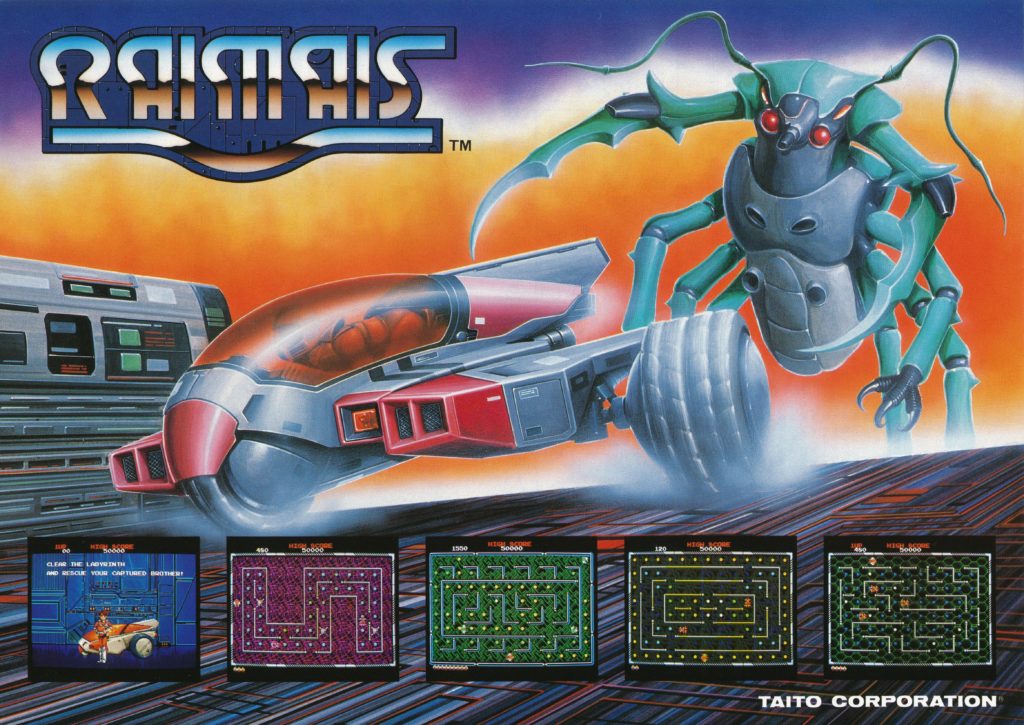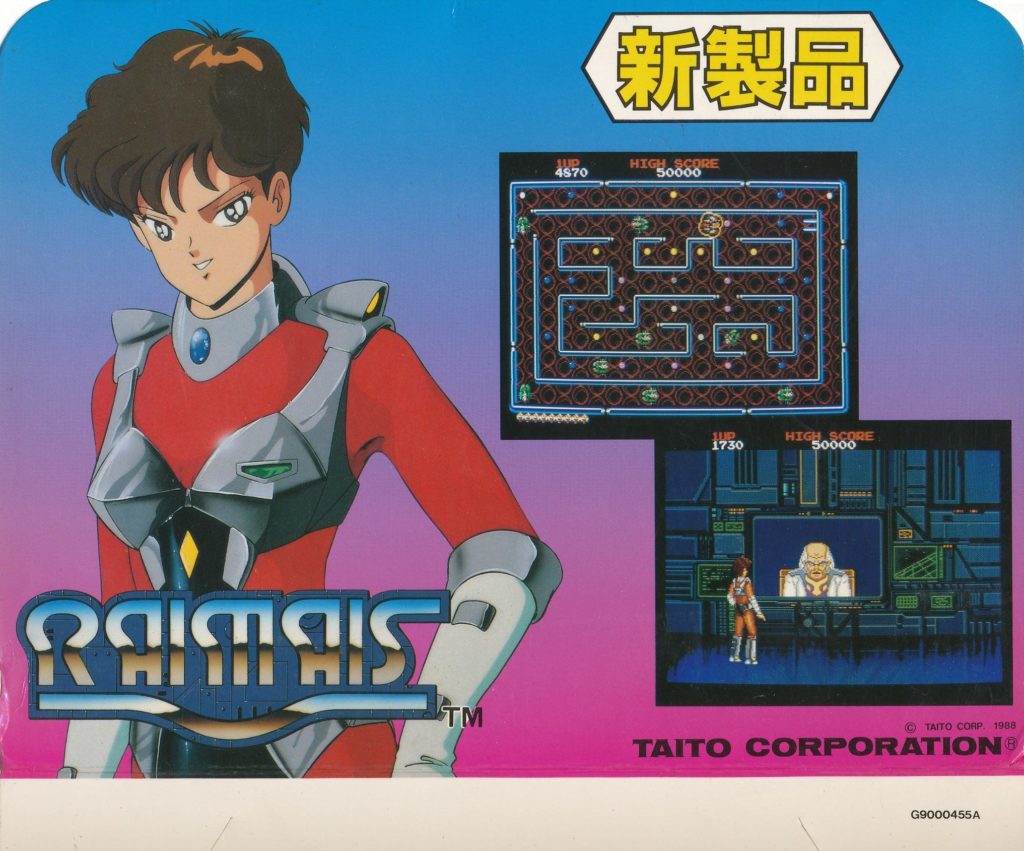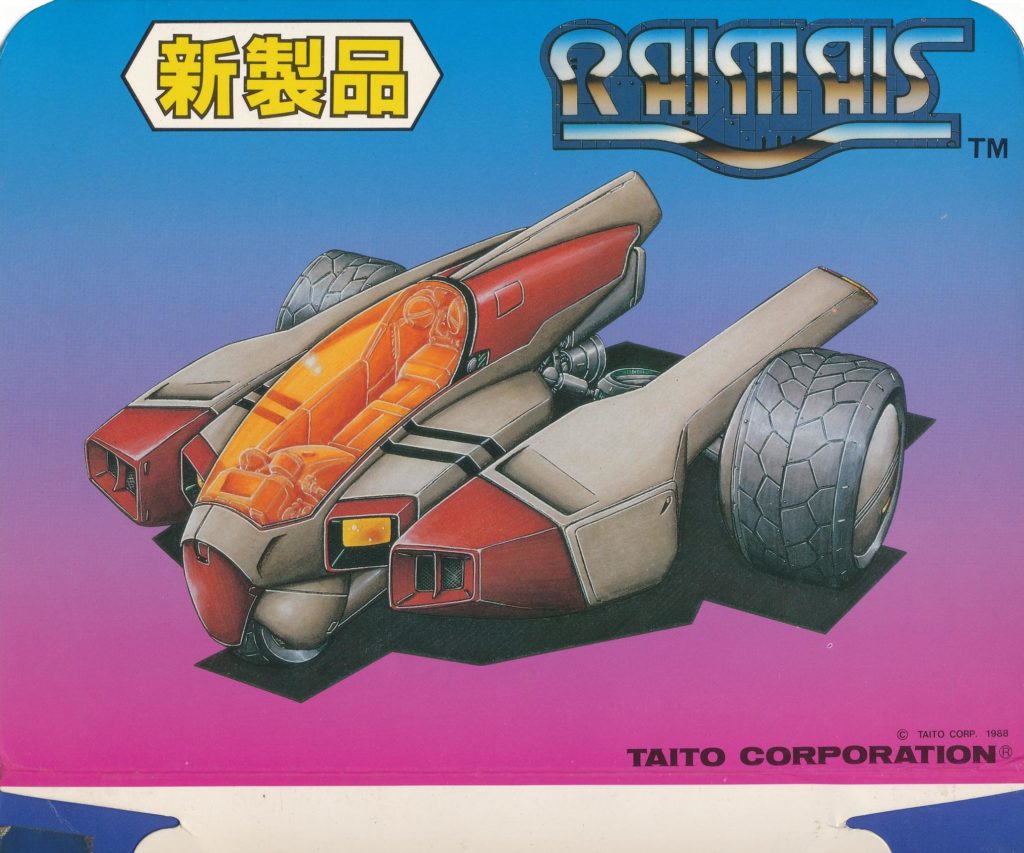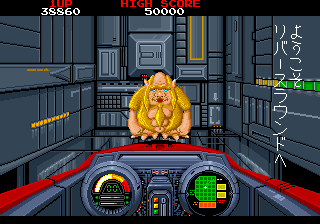Back in the mid-to-late-80s, Japanese arcades were the best thing ever. This is pretty much undisputed fact. There was a lot of technological innovation going on: Space Harrier and After Burner were using incredible scaling effects, Darius and Ninja Warriors were using multi-screen playfields, and racing and driving games were beginning to showcase elaborate cabinet design that would create unforgettable experiences you could only get at game centers. But among all the interesting experimentation going on, there was a steady demand for games in established genres as well: scrolling shooters, beat-em-ups, and action platformers that you operators could cheaply and easily plop into a standard JAMMA cabinet for players to pump 100-yen coins into.
In 1986, a creator at Taito by the name of Akira Fujita designed Arkanoid. The bounce-the-ball-to-break-stuff formula was well established at this point, but Fujita and his team managed to create a title that rejuvenated and redefined the simple concept that had been birthed years earlier, adding elements like enemies, power-ups, multiple block formations, and special blocks — all while giving the game an iconic visual and audio style. It worked beautifully — Arkanoid was a massive success, to the point where “Arkanoid” is the first title that springs to mind for many players when you talk about block-breaking titles.
A couple of years later, Akira Fujita and members of Taito’s Chuo development laboratory would approach another long-established genre to attempt to rejuvenate it in the same way they had with Arkanoid. This time around, they’d be taking on the “dot eating” genre, which was created by Sega’s Head On and propelled to worldwide success through Namco’s Pac-Man. They’d give it a fresh, 80s-anime-inspired visual look, more complex maze and enemy designs, power-ups, a backstory, and boatloads of hidden secrets that were common in Taito titles of the time. That game is Raimais.
Look at that key art. Doesn’t that just scream the ’80s? I first ran into this game many years back when I was scrolling through the Raine emulator library looking for stuff to try out, as I had just begun my voyage of discovery into “look at all these awesome old Taito games I never played” territory. Seeing an unfamiliar Taito title made me want to look more into it, and as I looked around a bit, images of crazy 80s-anime-and-TRON-style-futuristic vehicles, giant robotic insects, and a weird faux-chrome logo flooded into my search along with screens of several level layouts. Somehow, I had a gut feeling that this game was going to push my buttons, so I grabbed the ROM and booted it up right away.
I wasn’t wrong in the slightest.
When you begin the game, you see this scene, which evokes similar intros for other Taito titles – a very, very brief explanation of just what the heck is going on here. Clear the labyrinth and rescue my kidnapped brother, got it — at which point, the lead character hops into the machine and it vanishes in a flash of light, as the game’s main theme begins to ramp up. It’s a hell of a way to start things off and get you pumped for 32 levels of dot-crunching action. But it also showcases something that was rather unusual for arcade games at the time: a greater emphasis on cinematics and story.
I’m not going to pretend the plot of Raimais is some Shakespearean masterwork, but it did do a lot of interesting things for the era. 100 years in the future, the world of underground Holograph Racing is a thing, and our heroine — yes, heroine — is about to get a firsthand taste of how rough these physically tangible holograms are. Her name’s Rika Midorikawa (緑川理香), and her younger brother, Makoto, has been entrapped by a mysterious underground organization headed by the nefarious Mr. Molto. They’re the ones secretly behind this dangerous motorsport, and in order to get her younger brother back, Rika will need to fight her way through the labyrinth in her specialized vehicle, the Organizer. That’s her you see in the intro bit.
Official art from Raimais is incredibly hard to find! What you see above is one of very, very few official art images of Rika I’ve come across, and it was part of the promotional decoration set given to Japanese arcade operators who bought the boards to stick on their cabinets. My good friend Zekuu scanned this (and numerous other promotional bits) for me, which is beyond awesome of him. (He also tweeted this particular image out, which got some reactions from Japanese arcade fans of “Oh, I’ve never actually seen art of the older sister before” — that’s the level of rarity we’re dealing with!)
And here’s the Organizer. Pretty sweet, huh?
(Another interesting factoid Zekuu passed along to me is that, similarly to Ninja Warriors and the original Darius, the mech designs for Raimais were a collaboration with famed anime studio Tatsunoko. Their involvement with a lot of Taito stuff of this era seems to be an open secret in Japan, but they’re never explicitly credited in any of the games, leaving me to wonder a bit about just what the terms of those contracts were.)
So just who is Rika Midorikawa? It’s not explained much in-game, but I did manage to find a few bits from Japanese magazine previews from the era. She’s either 18 or 20 years old (info varies), a biking ace, and sometime before she got caught up in this whole Holograph Race mess, she was the leader of a now-disbanded bosozoku gang called the Estrous Cats. Er, with a name like that, I hope it was an all-female group…
Anyway, her younger brother’s the only blood kin she’s got left, and she cares for him deeply — enough to put herself at risk for his sake.
As Rika goes through the labyrinth, she’ll sometimes be confronted by her nemesis, Mr. Molto, who will pop in to mock her (or mockingly praise her) over these monitors. These bits are actually fully voiced, which was quite surprising for the era – voices beyond simple sound clips weren’t a thing heard often, and voices in a story context were particularly rare. (Remember, CD-ROM was still in its infancy and prohibitively expensive: Tengai Makyo Ziria, a PC Engine CD RPG that would wow the Japanese gaming populace with elaborate cinematics and lots of voicework, was still a year away.) Another interesting thing is that these scenes will actually change depending on your performance. This ties into the game’s warp system, which I’ll explain later on.
I’ve talked a fair bit about the game’s background, but I haven’t really touched much yet on how it plays, so let’s explore that now. If you’re familiar with any “dot eating” games — and come on, we’ve all played Pac-Man — you likely understand the base gameplay of this. Your goal in each stage is to collect all of the dot-shaped “energy plates” of varying colors while avoiding hazards and enemies. Pretty simple, no?
There are some very key differences to Raimais, however. For starters, the Organizer is equipped with a throttle that controls its speed: press it to go faster, release it to slow down. You’ll probably play around with speed a bit as you get the hang of the controls, but the moment you try to come to a stop, you’ll discover something that makes Raimais very distinct: you can never come to a complete stop. The Organizer must keep moving, quickly or slowly, at all times. If you hit a wall, it automatically turns and keeps on rollin’. It might not sound like much, but it makes something as simple as waiting for enemies to pass by a lot more challenging and strategic.
The other thing is that you aren’t just going through a single maze, or a set of looping mazes: there are around 125 different levels that you can encounter, though you’ll only be seeing 32 of them in a single playthrough. After you clear a stage, passages open up on all sides of the stage, leading to different areas — so after every level, you essentially have four choices of where to go next. It’s not a branching system like Darius or Night Striker: every stage number beyond the first has four set variations, and each color-coded area (Red for North, Green for East, Blue for South, and Gray for West) is open as a choice no matter which path you took in the prior level. Each stage varies not only in layout, but in the enemies, powerups, and obstacles contained within.
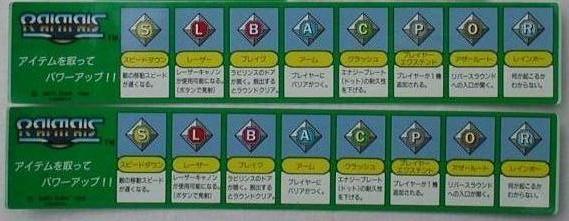 So that brings us to the power-ups, which are a pretty crucial part of the base gameplay. I’ll save descriptions of the enemies for the next section, which will highlight some of the moment-to-moment gameplay and stages that I think are particularly noteworthy. For now, let’s look at these items, because they do really interesting things!
So that brings us to the power-ups, which are a pretty crucial part of the base gameplay. I’ll save descriptions of the enemies for the next section, which will highlight some of the moment-to-moment gameplay and stages that I think are particularly noteworthy. For now, let’s look at these items, because they do really interesting things!
The first is S, for Speed Down, which reduces the speed of all onscreen enemies with a comforting skidding sound effect. As you spend more time on a stage, the speed of the enemies tends to gradually increase, so grabbing this can help calm things down a bit. Next is one of the more important power-ups, L for Laser. As you might suspect, this gives the Organizer the ability to fire pew-pews with the item button and destroy basically any enemy. The number of lasers you can have onscreen at once is limited by how many L power-ups you’ve gathered during the level, meaning you can’t just grab a single laser and rapid-fire your way out of trouble. (Don’t forget that enemies respawn after a few seconds, as well.) Fortunately, it sticks around even if you lose a life, but you will drop it at the end of a level.
B is Break, which functions similarly to the power-up in Arkanoid: it opens one of the stage exits prematurely, and if you can get inside, you can skip the current level you’re on. However, since you’ve only got one random exit out of four possible routes open, you have to decide if going that particular route is to your benefit. A is Armor, which puts a shield around the Organizer that both absorbs one hit and destroys the enemy or barrier it comes into contact with. Multiple A power-ups can stack, which is something you’ll need to remember: certain stages actually have barriers — sometimes in a row — that can only be destroyed by crashing into them with armor.
C is one of the more desirable power-ups to get: while it supposedly stands for Crash, it’s probably easier for English speakers to associate it with clear, as it’ll wipe every uncollected energy plate from the field and reveal the power-ups underneath. (In the case of some of the energy plates that need multiple run-overs to collect, it counts as one pass.) While it’s good for clearing stages quickly, you’d do well to remember that sometimes exposing every power-up on the field at once isn’t a good idea, and that all power-ups (including the coveted P and O, which we’ll cover shortly) vanish when the last energy plate is collected and the gates open. P is for Player Extend, and is one of the rarest pickups, usually only showing up on a lucky random power-up space.
Out of all of the power-ups, O is the most interesting. The O stands for Other Route, and picking one up will open a warp in the ground where the item was. If you run over said warp, you’ll be taken to what’s called a Reverse Round, where the gameplay changes significantly.
Here, you’ll have to fight one of the giant mecha bosses. Where Darius mecha were all aquatic-themed, all of the giant mechs you’ll encounter in Raimais are insectoid, and they all want you dead. Fortunately, there are four laser powerups on the field: you’ll need to grab them and fight back while avoiding colliding with the VERY LARGE moving bosses, who also fire projectiles of their own. Remember: you can’t ever stop moving, and that’s where a lot of the challenge in these mech fights lies.
There are four variants of the insect bosses, and while they all follow similar movement and attack patterns, they vary in terms of size and how many hits they take. The mantis is the easiest: it’s thin and goes down in 20 hits. Slightly more difficult are the beetle and fly, which are fatter and take 30 and 40 hits, respectively. The worst one by a country mile is the dragonfly, which not only takes 50 hits to kill, but has the largest hitbox of any of the bosses due to the size of its wings. It’s very easy to get boxed into a corner when you’re fighting one, which is difficult (though not impossible) to survive. Bosses are ties to stage, so if you know what lurks where, you can avoid the problem enemies.
(This won’t be the only time the gameplay will make a drastic shift, as we’ll eventually discover.)
After defeating the giant bug-mech bosses, you’ll be greeted by this… odd fellow:
“Welcome to the Reverse Round. I’m Gun Can, the being that resides in the Reverse Round. There’s no need to talk; telepathy will cause fewer problems.
Your name is Rika Midorikawa. You’re participating in this race for the sake of your kidnapped brother. If you win, you’ll get him back. But if you lose… the same will happen to you… I see.
I’ll give you items and hints… sometimes, when I feel like it. Let’s meet again, in a different round…”
Those are Gum Can’s words to you (minus “you can press a button three times to skip cutscenes”) the first time you finish the Reverse Round. This odd creature is a denizen of the labyrinth and seems friendly, offering Rika advice and items whenever she makes it past the giant cybernetic insect bosses. Sometimes he’ll just drop a few hints, but at other times, he’ll give you something extremely powerful you can use with the Item button, like an enemy stopper or the Hyper Armor. Occasionally he’ll make bad jokes and veer into mildly pervy territory — in one possible scene, he jokes about how Rika “leveled up” and “her height and bust size have increased!” Also, there’s something very special he’s looking for, and depending on what you do during the game, he just might find it and give it to you…
Phew, that was a bit of a digression, wasn’t it? Well, there’s still one power-up left, and it’s a doozy: R for Rainbow. Rainbow has a random effect, but whatever the effect is, it’s something comically overpowered that basically guarantees you beat the stage: hyper armor that can absorb a huge amount of damage before going poof, a tactical nuke, or just outright clearing everything in the level. The moment you see a Rainbow show up, you grab it.
So, that’s a… not-so-brief introduction to the setting and basic gameplay of Raimais. Next, let’s look at some of the moment-to-moment gameplay: enemies, stage design (including some hilarious dick design moves), the warps and key story cinemas… and THE ENDING.

